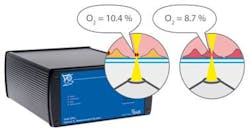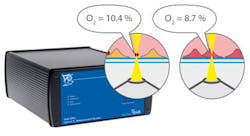New optical sensor can measure oxygen directly in cells, tissues
Biotechnology company ibidi GmbH (Munich, Germany) is presenting a new device that optically measures the exact oxygen content directly in cells and tissues. The ibidi OPAL Optical O2 Measurement System determines the correct oxygen content, which is a critical factor in maintaining the natural behavior of cells in culture. The tool is able to mimick the conditions of real tissue in in vitro experiments.
Related: A powerful pairing for cell studies: Correlative light and electron microscopy
With the system, extra- and intracellular oxygen concentrations in cells and tissues can be quickly determined in a few seconds. Subsequently, cell culture conditions can be adapted to the real conditions in tissues. In contrast to existing technologies, the measurement is noninvasive and occurs in real time, which is ideal for in vitro hypoxia conditions such as 3D cultures, spheroid models, and tissues.
The OPAL technology was developed by ibidi's cooperative partner, Colibri Photonics (Potsdam, Germany), and is now being marketed by ibidi GmbH. Company president Dr. Roman Zantl explains, "We, along with Colibri Photonics, want to advance the knowledge of oxygen conditions in cell culture because this is a crucial factor in cancer treatment."
Cells will only behave naturally when they are cultured under the specific conditions of their biological environment. In mammals, the most prominent conditions are temperature, pH, oxygen, and carbon dioxide concentration, and constant concentrations of salts and nutrients. To achieve biologically relevant results, it is crucial to maintain these conditions on the microscope stage during live cell imaging experiments.
In addition to controlling the oxygen concentration in the stage top incubator, it is indispensable to know the real oxygen concentration near the cells, or even inside the cells. Because cells consume oxygen, the concentrations are typically much lower in cell clusters, such as tissue or spheroids.
With the OPAL Optical O2 Measurement System, it is now possible to measure the real oxygen concentration directly inside the Petri dish. Oxygen-sensitive beads, or nanoparticle reagents, are used in combination with the system. By identifying changes in the fluorescence lifetime of these particles, the oxygen concentration in the immediate neighborhood—or directly inside the cells—can be determined.
-----
Don't miss Strategies in Biophotonics, a conference and exhibition dedicated to development and commercialization of bio-optics and biophotonics technologies!
Follow us on Twitter, 'like' us on Facebook, and join our group on LinkedIn
Subscribe now to BioOptics World magazine; it's free!

